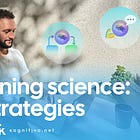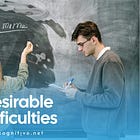A practical guide to learning anything: how value drives encoding
Your brain won’t memorize because you asked nicely. It will when you quietly raise the cost of not knowing. Here’s how to do exactly that, so you can make learning stick on purpose.
Consider the long and ugly German word “Aschenbecher.” (ashtray) I think even my German friends would agree it’s not the most beautiful word in their language.
My sister, a non‑smoker learning German while working in a Berlin restaurant, met this word twice. She learned it first in a German class, but the word didn’t stick. Later, when she started working at the restaurant, customers kept asking for an “Aschenbecher”. Suddenly it wasn’t just a list item anymore, it became a job requirement. The word instantly stuck in her memory.
Why didn’t it stick in the classroom but did at the counter? Would a smoker have remembered it better at the German course? What does this anecdote tell us about how learning and memory work? And most importantly: How can you recreate this process in your study sessions to boost your learning?
High-value information
The guiding idea is value-directed remembering: when your brain tags information as high value, it gets more attention and sticks better. This happens when the information helps with current goals, needs and interests, fits identity or carries rewards. Lower‑value material is not erased, it just slides down the brain’s priority list. Attention is a budget, relevance pays the bill.
Value from solving a need is the real lever. When information is instrumental to a task, the brain upshifts attention and engages reward systems, which deepens processing. That extra processing strengthens the memory trace at encoding. In practice, learning follows task demands more than study intention.
Make it useful on purpose
You can use the principle behind value-directed remembering in your study sessions. The job is to make the target information feel high value to the brain. But that’s easier said than done: how can you make a random page in your textbook feel like high value information? Most of the time it’s not relatable information at all. You can’t fake value. The brain notices.
That’s why most students choose a different but flawed strategy: they intentionally set their brains to directly focus on learning the information. Ironically, simply trying to understand is a poor way to achieve understanding. The brain does not follow commands like “Please, understand this.” Intention is a weak instruction set.
Rereading, rewatching and underlining without a goal other than “learning” will boost familiarity, not mastery. “Drill and kill” looks busy, but it does little for encoding information into your memory.
The key to leveraging the concept of high-value information is to focus on performing cognitive tasks that require the information, as opposed to focusing on the information in the abstract.
By performing a cognitive task that requires an understanding of the information, you’re actually creating the conditions for your brain to see the information as high value within the learning process, even without real-life needs having to be met (such as my sister’s job at the restaurant).
Learning is a byproduct of cognitive work
The counterintuitive reality is that learning and understanding aren’t cognitive tasks. Learning isn’t something we do. It’s rather something that happens when we do the right things. More precisely, learning is a byproduct of specific cognitive actions that force deep processing of the target ideas.
The intention to learn alone does not produce learning or long‑term retention.
Your brain learns new information when processing it is necessary to complete a cognitive action, something you do. But what is a cognitive action? Deciding, generating, simplifying, grouping, comparing, justifying, those are actions. Internal actions are invisible; we only ever see the outcome of our mental work (the text, the slides, the diagram…). But it is the unseen work that causes learning.
The shift is simple: stop measuring exposure, start measuring the number and quality of cognitive actions performed.
What cognitive tasks produce learning?
Summarizing
Simplify to essence. Put the same idea in fewer, plainer words, without the fluff. Summarizing is prioritizing: it forces a decision about what is central and what is garnish. If a concept can’t be said cleanly, it hasn’t been understood cleanly. Summaries are not old‑school busywork, they force you to engage meaningfully with the information. Example: while reading, give a title to every page on your textbook in 1 sentence.
It goes without saying that if you offload summarizing to an AI, it doesn’t work: it’s your cognitive effort that matters. Also consider: do different rounds of simplifying, summarize the summary again. It’s about the process, not the outcome.
Grouping ideas and concepts
Group to see structure. Placing items together pushes you past surface features toward shared logic, traits or implication. Grouping forces you to confront the pieces at a cognitive level. Example: cluster ideas by function or mechanism, then name each cluster in three words.
This is the logic behind mind maps: they are membership tests. Does this belong here? Why? Also: Groups do not have to be final. Regroup as new information arrives. The point is not the map, the point is the mapping.
Comparing and connecting
Make differences and bridges explicit. Comparisons force criteria, connections force an account of inner parts and logic. Analogies can help here. Example: “X is like Y because of A, B, C.” The juicy bits are the A, B and C.
When analogies break, that fracture is a gift: it reveals what the concept truly is (and is not). First drafts can be wrong, it’s not about getting it 100% right, since revising the draft is the superior task. Questioning analogies can be even more productive than creating them. You can also build mind maps that group, connect and clarify hierarchies.
Judging the information
Here is one place where being judgy pays off… not people, but information! Judging is about categorizing information as more or less important, as good or bad, as high priority or low priority. When you judge, you tie information to a principle, which is a small act of transfer. Judging means building hierarchy and this is another way of organizing, regrouping and sorting out information. But remember: judge information, not people! Example: Rank the five core ideas high → low and note the rule used.
What is encoding?
Summarizing, grouping, comparing and judging are simple cognitive tasks that trigger durable memory by making the information instrumental, but of course there are many more: rephrasing, justifying, storytelling... These tasks are a simple way to implement the generation effect, which is a desirable difficulty in learning.
Great learners do this almost intuitively, even while reading. You don’t necessarily need to write or produce any output (you can also summarize and make connections in your head, even though writing helps). And remember: do not stop at one pass. Summarize the summary, regroup the grouping, revisit comparisons, question past judgments again, and then again… especially as new information arrives.
The technical term for this process is encoding: converting information held in working memory into a durable long‑term trace. This information is then stored and can later be retrieved from the long-term memory.
Things to pay attention to
The kind of encoding task isn’t the whole story (of course, that would be too easy). Here are a few factors that also have a big impact and that I’ve already discussed here in Kognitivo:
Are you at the right level of challenge? If these tasks feel frictionless, they are too easy. The purpose of a cognitive action is to push past surface recognition into deep processing and rich details. Aim for the optimal challenge point. If you don’t feel the struggle, you’re likely not learning.
Don’t overdo it: Working memory is limited. Design tasks so attention goes to meaning, not juggling details. Reduce cognitive load: segment material, spotlight what matters, keep prompts sharp. Spend bandwidth on meaning, not clutter.
Retrieve, space, interleave: Encoding is the beginning, not the end. To keep information, pull it back out. Replace review with recall, then check, spaced over time. Mix topics so the mind stops coasting on sameness and starts noticing differences. Retrieval makes memory stronger; spacing makes it durable; interleaving makes it transferable.
You will have learned
Better encoding requires sitting with discomfort and making a habit out of thinking hard. The tasks above are the exercises, the burn is the point. Memory adapts to the quality of cognitive work it is asked to perform, again and again.
And yes, I know it feels strange to see it this way, but learning doesn’t happen because it’s intended, it happens because it’s required by the task one sets for the mind. Learning is not an action, but the result of an action. Strictly speaking, you’re never learning, as in “doing the act of learning”. Learning is what “will have happened” if you do certain actions the right way.
The confusion may stem from the fact that we use a verb (to learn) to refer to something that’s not an action, but a result. We understand this better if we use a noun and talk about producing learning, leaving the verb-form for the tasks that produce it: to summarize, to group, to connect, to judge…
If you found this topic interesting or if this article made you reflect, make sure to subscribe to receive more insights and practical tips on how we learn. And share this with someone who totally “will have learned” about this!
Keep learning
Prompt suggestions. Always ask follow-up questions:
Turn low-value info into high-value tasks: Give me a boring textbook fact and then show me how to transform it into a task (summarizing, grouping, comparing, judging, etc.) that forces my brain to treat it as high value.
Value-directed remembering in action: Help me design a study activity where I can make abstract textbook material feel “high value” to my brain. Use concrete examples from science or history, and guide me to turn them into tasks that require summarizing, grouping, or comparing.
Diagnose my study habits: Ask me to describe how I usually study for an exam. Then evaluate which parts are just “exposure” and which involve true cognitive actions. Suggest two specific changes that would make my encoding deeper and more effective.







